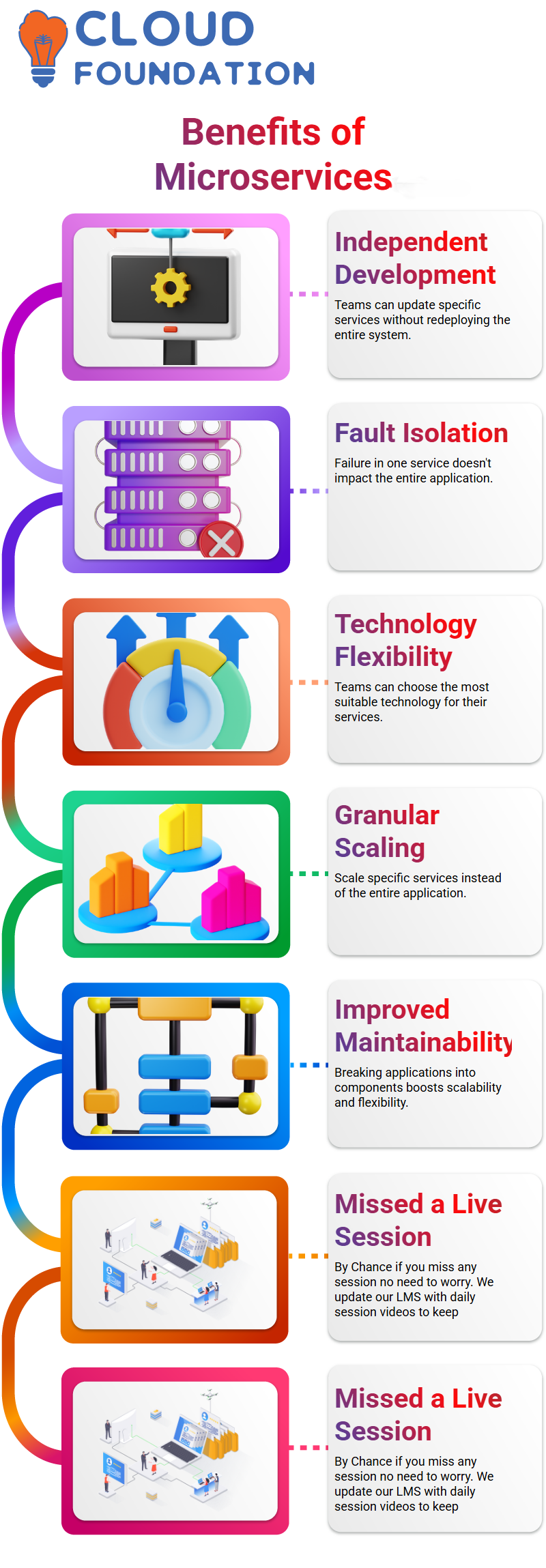Microservices Tutorial
Introduction to Microservices
Microservices have quickly become a key approach used by businesses for developing and deploying applications efficiently, offering numerous benefits like scalability, flexibility and easier maintenance. Microservice architecture differs significantly from conventional architectures and is comparable to technologies like Docker and Spring Boot.
Furthermore, various design patterns and tools may be utilized to accelerate development of microservice-based apps. Before microservices emerged, applications typically employed a monolithic architecture characterized by tightly interdependent software components connected via one architecture layer.
Monolithic applications function as one cohesive entity, necessitating all necessary components being present for proper execution. An application executing domain-specific logic, retrieving and updating database records, and rendering an HTML view for browser display all operate under one large container without being divided up into smaller services.

Microservices security is of utmost importance, with different strategies and tools used to safeguard them against vulnerabilities. Teams using them enable development, testing and deployment independently managed services faster for effective application management.
Microservices have become an indispensable element of modern application development. By employing appropriate design patterns and tools, developers are able to construct reliable yet secure software apps using microservices.
Microservices provide several advantages over monolithic apps. One advantage of using them is using various languages and technologies for developing each service of an application – for instance Python can be used while Go programming language can also be utilized by developers when building microservices applications.
Efficient Communication in Microservices
Microservices provide direct communication among applications of any programming language or platform using REST APIs. As opposed to traditional messaging middleware systems that rely on intermediary brokers for communication purposes, microservices enable direct interactions without intermediaries or mediators being involved.
So microservices allow seamless communication among different applications built using different technologies, even if their services use disparate approaches to development. Their service granularity enables software applications to be divided up into smaller independent services rather than functioning as one large system.
When multiple applications or services are involved in an operation, their communications only occur as necessary; this allows for optimal performance. Overall, microservices represent an efficient and scalable communication model to increase system responsiveness while decreasing dependencies between services.
Microservices Architecture
Microservice architecture is an independent system designed for greater ease and adaptability, consisting of discrete modules communicating via clearly defined interfaces. Stateless communication ensures seamless interactions, since each request and response function as independent transactions.
With its decentralized architecture, each microservice manages their own data model and storage needs independently. Contrasting traditional architecture that relies solely on one instance for all operations, microservices utilize multiple separate instances that operate autonomously from each other.
Each microservice features its own instance, codebase and deployment unit so small teams of developers can manage them more effectively. Key components include management, service discovery and an API gateway. Management oversees service placement, failure detection and load balancing while service discovery provides a registry of services with their locations to allow microservices find what they require quickly and easily.
API gateways serve as single entry points that permit clients to interact with specific services without directly accessing all. Microservices are purposefully small and focused; thus, making rewriting or maintaining them effortless.
As each service operates autonomously, development and deployment processes are faster. Updating one does not necessitate changes to any other services thereby streamlining deployment process.
Language neutrality is one of the key advantages of this architecture; different services may use various programming languages based on requirements; for instance, some services might utilize Python for rapid development while others utilize Java for better performance and library support.
Advantages of Microservices Architecture
With benefits offered by Microservices Architecture from Microsoft such as independent development, fault isolation, technology flexibility and granular scaling being key advantages of their microservices design. Independent development allows individual teams to concentrate their attention on specific services, making updates and maintenance simpler without needing to redeploy entire systems.
Fault isolation ensures that, should one service fail, its effects do not cascade through to bring down an entire application, improving reliability and manageability. With this architecture in place, teams no longer rely on Java EE containers; rather they choose technology best suited to support their services.
Granular scaling enables businesses to expand only required services rather than expanding an entire application, thus optimizing resource use and performance. To illustrate microservices concepts, three simple Maven projects may be created that illustrate it: doctor, patient and diagnosis.

The doctor microservice is used as the consumer, while patient and diagnosis microservices supply data. Each microservice has its own configurations and dependencies managed via POM files before being implemented into service.
The doctor microservice is comprised of an XML file for managing dependencies and a Java package used for configuration, while its patient counterpart defines variables like patient name and email ID while sharing common configuration with other microservices.
Microservices architecture improves scalability, flexibility and maintainability by breaking applications down into small independent components that work together seamlessly – an approach ideal for modern software development. However, this approach comes with its own set of challenges which must be considered carefully when developing microservices architecture applications.
Identify any significant technical obstacles with microservices architecture when developing applications with it.
Challenges in Microservices Architecture
Configuration management presents an immense challenge, since maintaining consistent configurations across diverse environments requires constant management and troubleshooting of multiple independent services requires probing each one independently to locate errors.
Centralized logs and dashboards can simplify error identification and troubleshooting, while maintaining consistency among microservices can present its own set of challenges; too many tools addressing similar problems could create inefficiency.
Decentralized governance is necessary for maintaining uniformity of languages, platforms, technologies, and tools used for development, deployment and monitoring purposes. Automation can be challenging due to multiple small components not integrated within one central deployment and monitoring system.
To address this challenge, developers often turn to tools like Spring Boot that optimize automation while improving scalability.
Faced with these hurdles, finding solutions requires devising and employing strategies and tools that improve observability, configuration management, debugging, consistency and automation – ultimately leading to more efficient microservice architectures.
Advantages of Microservices Architecture
With benefits offered by Microservices Architecture from Microsoft such as independent development, fault isolation, technology flexibility and granular scaling being key advantages of their microservices design.
Independent development allows individual teams to concentrate their attention on specific services, making updates and maintenance simpler without needing to redeploy entire systems. Fault isolation ensures that, should one service fail, its effects do not cascade through to bring down an entire application, improving reliability and manageability.
With this architecture in place, teams no longer rely on Java EE containers; rather they choose technology best suited to support their services. Granular scaling enables businesses to expand only required services rather than expanding an entire application, thus optimizing resource use and performance.

To illustrate microservices concepts, three simple Maven projects may be created that illustrate it: doctor, patient and diagnosis. The doctor microservice is used as the consumer, while patient and diagnosis microservices supply data.
Each microservice has its own configurations and dependencies managed via POM files before being implemented into service.
The doctor microservice is comprised of an XML file for managing dependencies and a Java package used for configuration, while its patient counterpart defines variables like patient name and email ID while sharing common configuration with other microservices.
Microservices architecture improves scalability, flexibility and maintainability by breaking applications down into small independent components that work together seamlessly – an approach ideal for modern software development.
However, this approach comes with its own set of challenges which must be considered carefully when developing microservices architecture applications. Identify any significant technical obstacles with microservices architecture when developing applications with it.
Challenges in Microservices Architecture
Configuration management presents an immense challenge, since maintaining consistent configurations across diverse environments requires constant management and troubleshooting of multiple independent services requires probing each one independently to locate errors.
Centralized logs and dashboards can simplify error identification and troubleshooting, while maintaining consistency among microservices can present its own set of challenges; too many tools addressing similar problems could create inefficiency.
Decentralized governance is necessary for maintaining uniformity of languages, platforms, technologies, and tools used for development, deployment and monitoring purposes.
Automation can be challenging due to multiple small components not integrated within one central deployment and monitoring system. To address this challenge, developers often turn to tools like Spring Boot that optimize automation while improving scalability.
Faced with these hurdles, finding solutions requires devising and employing strategies and tools that improve observability, configuration management, debugging, consistency and automation – ultimately leading to more efficient microservice architectures.
Transition From Monolithic to Microservices
An understanding of microservices, monolithic architecture and Docker is integral for creating scalable solutions. Monolithic architecture presents unique difficulties due to its intricate, tightly connected structure.
Modifying and scaling such systems are complex processes due to all components running from a single instance using one database for storage purposes. As such, they lead to high memory usage, ineffective caching strategies, and difficulty independently scaling components.
Furthermore, adopting new frameworks or technologies may prove cumbersome due to dependencies among different parts of an application. Transition from monolithic architecture to microservices by breaking applications down into individual services can provide an efficient solution, making management much simpler.
Docker containers make deploying user services and test databases easily manageable.

Microservices differ from monolithic applications in that they operate separately with separate databases and load balancers for each service, unlike their larger counterparts which rely on technologies like Node.js and MySQL to perform tasks.
Microsoft’s microservices architecture follows a domain-driven model in which each service, like search, build and configuration are managed independently of one another.
Dedicate load balancers to each service to increase flexibility, enabling applications such as Microsoft Office to support multiple devices while remaining scalable and adaptable. Docker’s Use in Microservice Deployments
Role of Docker in Microservices Deployment
Docker containers play an indispensable part in microservices deployment by providing lightweight alternatives to virtual machines and pre-allocated RAM allocation.
Docker’s lightweight approach means that virtualized environments don’t have to rely on host operating system resources for running processes whereas, unlike their counterparts, Docker containers do not rely on pre-allocation.
Each container comes equipped with all the required binaries, libraries and dependencies, improving portability and efficiency. Prebuilt Docker images hosted on Docker Hub make container deployment simpler.
Users can retrieve images using the “docker pull” command, which checks local systems before retrieving from Docker Hub. After which, “docker run” launches containers automatically allowing seamless application execution.
Docker offers users an opportunity to further their understanding by visiting its official website, setting up an account, and starting work on microservices deployment. Docker makes microservice deployment easy – an invaluable asset in modern, scalable software development environments.
Configuring Dockerfiles for Microservices
Establishing a Dockerfile in the user service directory involves customizing it to meet specific requirements. A Dockerfile will then be generated there that contains test databases, user services, composed camel files and integration tests for integration purposes.
CMD runs Node executable when the container shuts down; while ADD copies all files to “app” folder within container and RUN executes commands inside image to expose modules installed within image.
To set up the test database, two files must be generated: Dockerfile-setup.sql and MySQL 5. These documents allow for configuration of a MySQL 5 database using important details like password, name and surveys as well as credentials that identify its owner.
Docker entry points provide an effective means of initializing database files, with root password, database name and additional configuration parameters being defined before saving and closing a Dockerfile.
Having such an arrangement in place ensures adaptability and efficient management of custom Docker images as well as containerized applications. Hence, their popularity remains undiminished today. Developing and Running Docker Containers.
Building and Running Docker Containers
Docker commands for creating and running containers include using docker build -t test-database to produce an image from its Dockerfile and docker run -it test-database to launch and manage it.
Docker Compose simplifies container management by outlining relationships among multiple containers within an environment. A docker-compose.yml file is then generated in your project root that specifies these interactions between several Docker images or containers.
Each container’s build values can be set out by specifying paths to its Dockerfiles, linking containers with database environments and setting dependencies.
Once complete, use docker build to generate the database image, clear your terminal of any clutter, sign in as root user and run docker-compose up for execution of application on port 8123. Service should successfully start on port.

Additionally, this discussion highlights differences between Service-Oriented Architecture (SOA) and Microservices Architecture. Monolithic applications combine all software components into one entity that makes them inflexible, unreliable and hard to scale up or scale out.
Microservices architecture makes for more agile software architecture solutions with the potential to scale smoothly without strain on infrastructure resources or software performance. Monolithic applications must be completely rebuilt every time an update occurs, impeding continuous development.
On the contrary, microservice architecture provides solutions that enable independent development, deployment and scaling of services without rebuilding entire applications – which allows continuous development to continue without stopping midstream.
Microservices in E-Commerce Applications
E-commerce platforms depend on key components like the shopping cart and product catalog to deliver services effectively to users. A shopping cart allows them to add products, manage checkout, calculate tax amounts, bill totals and track product details like name, ID rate quantity color etc.
Product catalogs contain details about available items, such as their name, ID number, rate rate quantity color. In an SOA-based RSA shopping application these tasks form one application service.
Microservices divide up these services into smaller and more manageable parts – shopping cart, product catalog and user account services for instance – that make up microservice architecture. Billing services also handle shipping options separately by including billing management as a dedicated microservice within its architecture.
Product catalog services have also been divided up into various services that specialize in displays products or updates displays like display product service, update display service, user default service and email notification service.
Microservices enable better modularity and scalability by breaking tasks up into individual services that offer greater modularity and scalability. At its core lies a display image server which handles product image rendering.
Should changes arise such as modifications in image dimensions or licensing restrictions, updates must be implemented across all related applications to maintain consistency and ensure uniformity of experience for end-users.
Shopping carts, product catalogs and microservice-based applications are key elements of an e-commerce platform, offering enhanced customer experiences while simultaneously needing careful adaptation to ensure compatibility and functionality.
Microservices provide greater agility and efficiency by breaking services down into more manageable pieces, known as microservices.
Role of APIs in Microservices Architecture
APIs play an essential part of Microservices Architecture by acting as intermediaries between clients and various application functionalities.
Each functionality is contained within its own microservice, so when clients request products they’d like, such as fetching all available ones, the appropriate microservice processes it before returning a response to them.
Traditional monolithic architectures typically combine multiple functionalities into a single entity and use one central data access layer and database for accessing data, while microservice-based systems operate differently; here, each service operates separately with its own API, data access layer and database access points.
Example of Microservice Architecture As an illustration the customer microservice includes its own dedicated API, data access layer and database; similarly, the product and cart microservices may each possess independent APIs and databases.
Microservices don’t necessarily need their own databases; depending on business needs and system design, some may share one instead. APIs and microservices play a pivotal role in providing seamless communications between clients and various functionalities in an app.
Improving Microservices with Database Design Patterns
Database design patterns are key for effectively overseeing application state in microservice architectures and guaranteeing smooth operations. By limiting database access to two or three microservices, scaling issues are minimized while performance increases significantly.
Event Sourcing Pattern allows developers to easily monitor changes within an application by storing events as sequences; thus, enabling easier state adjustments and data queries. Branch patterns provide for simultaneous processing of requests and responses from multiple independent microservices, providing maximum flexibility when consolidating results across services.
Command Query Responsibility Segregation (CQRS) pattern also facilitates performance and scalability when retrieving data: by segregating commands (create, update or delete) from queries (read), CQRS separates these two aspects and improves both their handling.
These patterns collectively help enhance database management, simplify application state maintenance and increase overall efficiency.

Vanitha
Author



